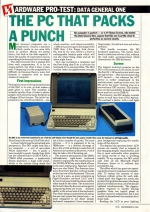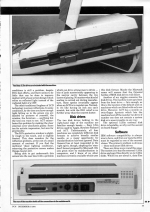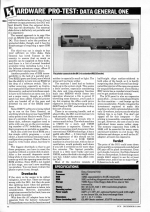
Personal Computer News
 15th December 1984
15th December 1984
Categories: Review: Machine
Author: Simon Craven
Published in Personal Computer News #091
No computer is perfect - or is it? Simon Craven, who tested the Data General One, argues that this one is pretty close to perfection on several counts.
The PC That Packs A Punch
No computer is perfect - or is it? Simon Craven, who tested the Date General One, argues that this one is pretty close to perfection on several counts
Most personal computers are a compromise. Usually, a machine which excels in one area falls down in another. Maybe it's pretty heavy, but look at the disk capacity! I know the quality of construction leaves something to be desired, but it's so cheap!
The Data General One is almost free from such compromises. It is by no means perfect, but what it does, it does well. Comparing it to the competition is difficult, not because there is none, but because it compares with so many classes of computer.
First Impressions
Perhaps the most striking characteristic of the DG1 is its size, so that makes a good place to start. The machine is actually smaller than it looks in photographs, with about the same footprint as a Dragon 32 but thinner. The initial impression is one of mild incredulity - can Data General be serious? £3,675 for *this*?
A closer look brings the price back into perspective. The DG1 might look like a toy computer - a sort of up-to-date Petite typewriter - but it packs a heavyweight's punch. Inside that little box are crammed up to 512K of RAM, a CMOS 8088 processor, a moderately decent keyboard, a huge LCD panel, which is the outsize thing about the whole machine, and almost incredibly, 1.4Mb of mass storage in the shape of two 720K Sony 3.5" floppy disk drives. Oh, and by the way, there's a built-in rechargeable battery pack which will run the whole thing, disks and all, for about eight hours.
Give any journalist a computer and the first thing they'll do is criticise the keyboard. It's a natural reflex. The DG1 version looks straightforward enough, but it has a number of quirks. The most obvious - if it is supposed to be an IBMulator - is a distinct shortage of keys, but a little probing reveals that all functions are present and correct, even if they do take a bit of ferreting out.
The numeric personality of the IBM's schizophrenic right-hand keyboard cluster is replaced by the combination of the NUM LOCK key and a block of keys in the main typing area. Separate cursor keys are also fitted. The function keys move from their familiar vertical stacks to the top row of the keyboard. This can be a bit of a pain, as many programs e.g. Flight Simulator, use keys 1, 3, 5, 7 and 9 for one lot of associated functions and the other stack for the other. The instinctive feel is lost when the keys are arranged in a long string from one to ten. Another oddity is the actual size of the keyboard. The whole thing is scaled down by about ten per cent across the lateral axis - at least compared to all other 'proper keyboard' computers I have measured. Surprisingly, this did not turn out to be a problem.
That hurdle overcome, the DG keyboard impresses. The tactile feedback is a delicious velvety click, without the loud audio accompaniment which characterises the IBM keyboard.
Screen
The biggest technical surprise on the DG1 is its enormous LCD screen. It isn't the first 80 x 25 liquid crystal unit to see the light of day - that honour goes to the ACT Apricot - but whereas the ACT device is rather compressed in the vertical plane, making circles oval, the DG gives the same viewing area as a conventional CRT monitor. The characters are the beautifully formed ones we know and love on the IBM PC.
Fortunately, the DG's display is much easier to read than that of the Apricot. The contrast is better, with a cool light grey background replacing the murky green of the Apricot.
The display also operates faster. LCD screens are usually slow to respond to fast-changing display requirements, and this is most noticeable when graphics are being moved or text is scrolling rapidly. To my surprise, the DG1 could cope with all the Microsoft Flight Simulator threw at it, without any perceptible lag.
The effort which has gone into speeding up the screen's responses is considerable. To reduce the amount of time between refresh cycles for each individual pixel (the bigger the screen the greater this problem becomes), the large panel is divided into four, all of which are updated simultaneously. The jiggery-pokery required to handle moving graphics from one logical panel to another must be substantial, but I was unable to disembowel the machine for a closer look.
Reading the LCD is poor lighting conditions is still a problem, despite DG's best efforts, and there seems to be little can be done to improve matters with a basic screen design which relies on reflected light instead of the radiated light of a CRT.
The other traditional bugbear of LCD technology is screen reflections. In some conditions, by the time you have enough light falling on to the screen you are dazzled by pictures of yourself, the window, the furniture - anything but the text you want to see. ACT exacerbates this problem by making the clear external cover absolutely glassy. Score ten for artistic impression, but zero for practicality.
The DG's protective window is slightly rough to the touch, and is slightly rough to the touch, and is slightly frossted. This does wonders for the reflection problem, at the cost of a small amount of contrast. If you find the mythical "ideal lighting conditions", removing the protective screen makes things clearer still.
Being able to get underneath this screen lets the user deal with a problem which can drive strong men to drink - bits of junk mysteriously appearing in the narrow cavity between the two layers of glazing. No matter what kind of sealing is carried out during manufacture, these specks invariable appear when an LCD is in regular use. Normally it's like having an itch you can't scratch, but with the DG1 relief is no further away than the nearest duster.
Disk Drives
The two disk drives lurking in the right-hand edge of the machine are familiar enough beasts- Sony 3.5" drives used by Apple, Hewlett-Packard and ACT. Unfortunately, all four machines use completely different disk formats to achieve broadly similar results, so a major opportunity for standardisation has been ignored. Data General has at least responded in the right spirit, though, adopting the 'standard' format proposed by Microsoft. DB sets great store by standardisation in computers, and I know of no other machine currently available which uses this disk format. Maybe the Microsoft name will ensure that the Oriental hordes of MSX disk drives will follow.
Another of my niggles concerns the disk drives. The machine is set up to boot from the front drive - fair enough, as this is the location of the default unit on machines which are fitted with only one drive. However, ACT has a system on twin-floppy Apricots which lets the machine boot off the number two drive if number one does not contain a system disk or is unserviceable in any way.
The optional 5.25" external disk drive is bootable, so why not the second on-board floppy?
Software
IBM software compatibility is always nice to have, and from our tests the DG1 must be regarded as one of the nearest clones. The primary problem is obvious - those miniature disk drives.
There are three ways round this snag. The easiest is to buy the external 5.25" drive and copy files directly on to 3.5" disks. While you are about it, data files can be transferred as well. If any of your software is copy protected, the DG1 will boot directly from the external drive. This has two drawbacks. The external disk drive is definitely not portable and it is expensive.
The second approach is to copy files over an RS232 link from an IBM to the DG. This doesn't solve the problem of protected disks, though, and it has the disadvantage of requiring a spare IBM PC.
The third way out is simply to buy your software on 3.5" disks. Data General has hired Tamsys in this country to ensure that as much as possible can be supplied on Sony disks, and there is a list of several hundred available titles including Lotus 1-2-3, the Infocom adventure ange, dBase II and Wordstar among many others.
Another possible area of IBM incompatibility is the lack of a parallel port. Two RS232 ports are fitted, one of which has the ability to turn into an RS422 at the drop of a software switch. This is rather annoying, especially as Centronics-type parallel printers are the rule in this country, and serial interfaces usually have to be bolted on at extra cost. It is not a major worry, though, as a BIOS patch has been added. Parallel printer calls are headed off at the pass and diverted via one of the RS232 interfaces.
Some IBM PC software is being tidied up to run on the Data General, as anything which does not use 'legal' BIOS entry points is not likely to work. This is less of a problem than it used to be - these days, software suppliers tend to write with one eye on the ever-increasing number of PC lookalikes, making their programs as portable as possible.
Built into a left-over bit of ROM are a few simple utility programs - a text editor, a dumb terminal emulator and a configuration program. None of these is much to write home about, but they're free.
The biggest drawback is that to get these programs, you have to reset the machine without a system disk in place. After a few seconds' desperate scrabbling while it tries to boot, the computer comes up with the opening menu for the ROM utilities. Since DOS is not loaded at this stage, you can't save anything you produce. You can beam it down the phone or print it out, though.
Drawbacks
If the story so far seems to be rather eulogistic, never fear. There are things wrong with the DG1, but they do seem like splitting hairs when the performance of the basic machine is taken into consideration. However, journalistic scepticism screwed to the limit, here are a few points to ponder.
Why does the AC adaptor have to be separate from the battery recharger? They perform very similar functions and neither is especially small or light. The price isn't too funny either.
The machine I used had no battery back-up to the system clock. This seems a little careless, especially considering the date and time-stamping function built into MSDOS which comes into operation whenever a file is saved. If travelling some distance, you'll pack it up, but crossing the office could prove expensive. It's one thing to trip up with a £400 Tandy or NEC, and another to drop this sort of money.
There is no carrying handle, and at about 12lbs, the DG1 is a bit too heavy to tuck securely under one arm.
Internally, the DG1 reveals why it costs so much to buy. The whole machine is CMOS for a start, and CMOS architecture is expensive. Chosen because it consumes much less power than conventional NMOS technology, it has a useful side effect - it runs much cooler. The importance of this should not be underestimated - a 512K NMOS machine in a box this size, with no fan or ventilation, would probably melt down if you left it switched on for more than five minutes. The Apricot portable, which is a little more bulky and uses NMOS, makes the disk in its single drive very hot. I didn't notice this effect with the DG1.
Most of the machine consists of half-height chips surface-soldered to both sides of the board, so it is hardly surprising that Data General has designated the interior of the case a no-go area for unqualified personnel. If you think a BBC Micro has a crowded circuit board, you've got another think coming.
The LCD panel is also an expensive piece of kit - it was invented specifically for this machine - and bumps up the price considerably. Finally, imagine the investment required to make this machine in a fully automated plant with only 12 workers, and you can see why the bottom line is so high. You don't get ripped off for this computer - the pricing is reasonable, considering what you get. However, the cost of one or two individual items seems rather steep. The memory expansion from 128K to 256K will be essential for many users, and £2 per kilobyte is a lot to pay. The batteries and charger, as well as the AC adaptor, all seem too expensive.
Verdict
The price of the DG1 could come down quite quickly as component costs fall and DG pays off its plant investment. Even as it stands, however, the Data General One is a fine product. It does things most people didn't expect to see for at least another tear, and it has no major flaws. It deserves to do well.
Technical Specifications
| System: | Data General One |
| Processor: | 80C88 |
| RAM: | 128K expandable to 512K internally |
| ROM: | 32K including diagnostics and terminal emulation |
| Storage: | 720K Sony 3.5" floppy disk drive, one or two internally |
| Display: | 80 x 25 LCD, 640 x 200 resolution graphics |
| Operating System: | MSDOS 2.11 |
| Power Supply: | 240V or 110V AC, optional battery pack with eight or ten hours life, six hour recharge time |
| Dimensions: | 13.7 x 11.7 x 2.8" |
| Prices (Excluding VAT): | £2,490 (Basic system), £3,675 (Enhanced System) |
This article was converted to a web page from the following pages of Personal Computer News #091.




